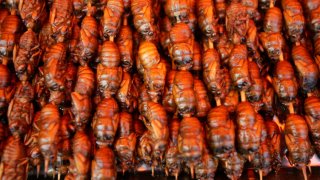
Billions of bite-sized snacks are about to appear in your backyard.
After nearly two decades living under the earth, cicadas are about to shake off the dirt and invade our great outdoors. And they’ll be ripe for your feasting says Isa Betancourt, an entomologist from the Academy of Natural Sciences of Drexel University.
“It’s a delicacy that’s rare,” says Betancourt, who’s known to dine on a few bugs from time to time. She calls cicadas "the shrimp of the land.”
“They are arthropods, which means they have an exoskeleton,” she said. “We regularly eat the arthropods of the sea and those are the shrimp, lobsters and crabs. And so cicadas are arthropods too.”
The Magicicada, as this type of cicada is named, spend 17 years underground snacking on the roots of plants, trees and vegetables. Now they’re coming above ground to shed their skin and mate.
Like other edible insects, cicadas are nutritious, according to Betancourt. She says their bodies are high in protein, low in fat and feature a lot of muscle.
Betancourt suggests trying to grab the magicadas when they’re fresh from the ground and undergoing their molting stage, which consists of shedding their skin as they prepare to fly away to find a mate.
U.S. & World
Stories that affect your life across the U.S. and around the world.
“That’s when they’re softest,” she said. “When they first emerge, they’ll be kind of a green color and after a few hours they’ll harden.”
The scientist says you’ll most likely find the soft cicadas in the morning hours. She says you can still eat them once they harden, but you should expect a little extra crunch. You’ll also want to pull off the wings, because, like corn kernels, they can get stuck in your teeth.
There are a couple dozen recipes for how to specifically prepare cicadas. Betancourt is planning on taking an old shrimp skewer dish, her grandmother has made for ages, and substitute in the insect. She also suggests boiling your insects first to quickly kill and clean them.
Online you can learn how to make Cicada-Portobello Quiche or a German Chocolate Cicada Cake – complete with a coconut-pecan frosting.
Cicada-Licious, a cicada cookbook (yes, this exists), has a number of other interesting ideas. The book was penned by University of Maryland entomology professor Mike Raupp and a group of students named the Cicadamaniacs. They put the book together when a brood, or group, of magicadas made their appearance around Maryland in 2004.
“I’ve had them several different ways and frankly, I’ve enjoyed them every way I’ve eaten them,” he said.
Raupp has been studying, teaching about, and feasting on cicadas for years. The insect ecologist is now working on a Discovery Channel special about the magicadas. He says as for how they taste, it really depends on how the insect is prepared.
“Boiled they’re going to taste a lot like shrimp. If you eat them au naturel, raw, they’ve got a delicate nutty flavor; a buttery texture,” he said. “I like the soft-shelled ones.”
Both entogastronomists -- what insect eaters are called -- warn those with food allergies, specifically those who are allergic to shellfish, should consult their doctor before eating cicadas. Betancourt says you should also avoid binging on cicadas that have been living in areas where a lot of pesticides have been used.
While eating insects is taboo in the United States and other Western cultures, that’s not the case for the rest of the world. The Food and Agriculture Organization of the United Nations estimates 2.5 billion people, mostly in Africa, include insects in the regular diet. Raupp says in some parts of the world, bugs make up as much as 20-percent of some culture’s diets.
For the squeamish, Raupp says he has a land and sea analogy he likes to use.
“Have you ever eaten an oyster or a clam out of the bay? It lives on the bottom of the bay and filters, you know what (feces),” he said. “You’d eat this thing, but would not eat this delectable insect that’s been sucking on plant fat for 17 years? I think it’s weird.”
Betancourt is more pragmatic, offering this piece of advice for the cicada-eating virgins: “Close your eyes when you’re taking the bite.”
Contact Vince Lattanzio at 610.668.5532, vince.lattanzio@nbcuni.com or follow @VinceLattanzio on Twitter.



